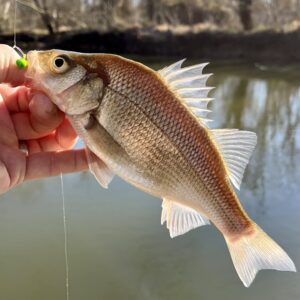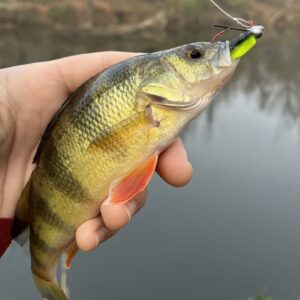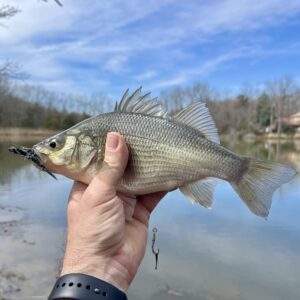Anglers who have long vied for their bank spot to hook into one of the most anticipated species migrations each spring—that of American and hickory shad—know well that their runs from the Atlantic up and into the spawning tributaries of the Chesapeake Bay usually begin sometime between the bloom of cherry blossom and dogwood trees. At the Tidal Basin in Washington, D.C., where some of the world’s most renowned cherry blossom trees exist, peak blooming reportedly occurred on March 17th—the second earliest peak on record (first being March 15th, 1990).
With the mild winter and recent warmup the region has experienced, it came as little surprise that the blossoms arrived early. So, too, did we hear the first fishing reports of shad running Potomac waters at Fletcher’s Cove—another location equally renowned for being a harbinger of spring’s arrival. Hickories started making their presence known a full two weeks ahead of Fletcher’s boathouse opening for the season (opening day was March 23rd). A couple anglers also reported consistent catches of hickories at Mason Springs (also on the Potomac/Mattawoman Creek).
A few miles eastward, on the Patuxent River, I hooked into my first hickory shad on March 21st—almost a full month ahead of the past two seasons’ runs along the same stretch of river I fish. I felt this was a rogue catch, a loner, as I was unable to get another fish to hit a lure on that outing. But good news…
Within a week’s time, the hickory shad were running pretty well along the upper portion of the Patuxent River. Personally, I enjoyed a fantastic morning of shad fishing on Good Friday (March 29th). As I walked through the woods to my preferred spot, patches of bluebell flowers had erupted along the banks. A good sign. Though I hooked into only five solid fish, landing three, I considered the outing a wild success, if only because catching these shad nearly a month ahead of schedule is quite exciting.
The shad reports have also increased at Fletcher’s—and more anglers are reporting catches at their other hotspots throughout the Chesapeake watershed. The first American was also reported last Friday at Fletcher’s, so it won’t be long before we see more of these larger shad in the mix. I recommend subscribing to Mark Binsted’s weekly Shad Report presented by Friends of Fletcher’s Cove. Binsted’s report is chock full of angler anecdotes and detailed catch information, including the hot lures of the week.
If you’re itching to know a few of the public hotspots to try your hand at shad fishing, there are five detailed at the Maryland Department of Natural Resources website.
For gear, I enjoy the fight of both hickory and American shad on light-fast rods of 6-foot length. Spinning reels in the 1000 to 2500 size work quite fine. Set the drag to medium tightness, as you’ll want to wrangle in the fish relatively quickly before they have a chance to dive deep or into cover (fallen trees along the banks, rocks, etc.). The fight will likely be a short frenzy and can be acrobatic. It’s fun.
I always take at least two rods (same setup, except lures); one to accommodate a classic tandem shad rig, which entails a shad dart tied to the mainline leader (8# test fluorocarbon) with a foot-long section of same material tied from the dart’s hook shank down to a gold or silver nungesser spoon—sometimes another dart. (There are many ways to tie these rigs, but I defer to the simplest.)
In the water I fish most often for shad, I may shorten the line from dart-to-spoon to 8-inches to avoid snagging bottom in shallow environs. In deeper water, you may want to lengthen the leader between dart and spoon. Lure weights could be anywhere from 1/32-ounce to 1/8-ounce. At Fletcher’s, some anglers may upsize to 1/4-ounce darts for distance casting and to reach deeper pools of water.
My second setup usually has a 1/8-ounce stump jumper tied on—it’s a small underspin jig with a curly tail or stinger soft plastic tipped on. My best morning of shad fishing in 2023 had most catches coming on the stump jumper.
Bring many colors of these lures with you in various bright and dark shades. The shad can be finicky—electing to hit a single “color of the day”…or several. You’ll never quite know until you start fishing.
Often the shad are situated—that is to say, buoyantly hovering and facing upstream—in the line of water between current and slack. When approaching your fishing spot, observe the water for a few minutes to see where this distinction occurs in the water. Cast out and upstream. Feel your lure drift along as it swings back toward you and the demarcation between the current it’s in and the slack water closer to you. Pay attention to the depth you’re fishing. Give the lure a few twitches. You’ll feel the fish grab your offering and with a snappy hookset, it’s game on! (Note: do not use a power hookset like in largemouth bass fishing as the shad’s mouth is rather delicate).
If you’re lucky enough to net a shad, savor the moment, albeit quickly. In Maryland, this is a catch-and-release fishery only. Safe handling and a quick release will help ensure the frisky buck or roe shad swims away upstream to reproduce the next generation of fish for anglers to pursue…just as the cherry blossoms begin to bloom anew.







